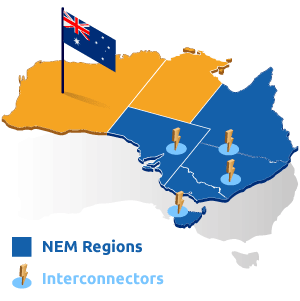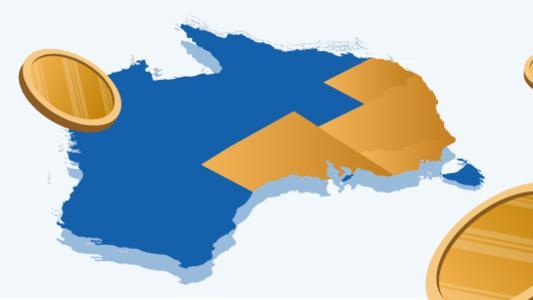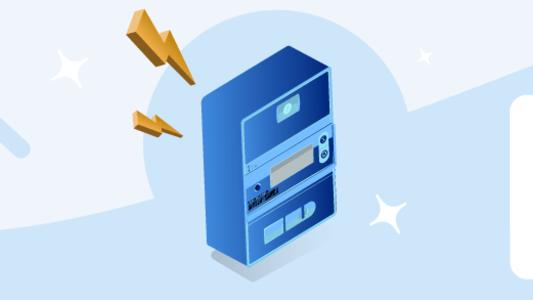The National Electricity Market: What is the NEM?

The National Electricity Market (NEM) is the Australian cross-state energy grid, which brings electricity to Queensland, New South Wales, the Australian Capital Territory, Victoria, Tasmania, and South Australia. Below we explain how the NEM works, who governs the NEM, and how prices are set and how energy reaches your home.
What is the NEM in Australia?
Part of Australia runs on a consolidated energy network called the National Electricity Market (NEM).
The NEM ensures energy is generated, traded and transported in a carefully balanced system that aims to supply and match real-time energy demand in the southern states and the east coast of Australia.
Australia has 2 parts to its energy market:
- A regulated energy market
- A deregulated energy market called the National Electricity Market (NEM)
Therefore, Depending on where you live, you may receive your energy from the NEM or from your state's energy market instead. In total, the NEM supplies around 80% of electricity in Australia, reaches roughly 9 million customers and manages over 40 thousand kilometers of energy lines.

Which States Are Part of the NEM?
The NEM manages energy supply in the following Australian states:
The other states, Western Australia and the Northern Territory, are areas where the energy market is still regulated by the government and you don’t have a choice (or less of one) in your energy provider.
Apart from being able to choose your own energy provider, the NEM also has a reference price known as the Default Market Offer (DMO) or the Victorian Default Offer (VDO) if you are in Victoria, which informs customers about the fair price for energy and acts as a price cap to protect customers from being charged anything higher.
While the Northern Territory and Western Australia are not connected to the NEM, however, they have adopted certain aspects of the National Electricity Market.
Need Energy Advice ?
Selectra's Energy Experts are Available To Help You Free of Charge
(Free Selectra Service - Currently open)
How Does the National Electricity Market Work?
Electricity in the NEM is regulated by governing bodies that manage energy transactions between generators and retailers. The retailers, or energy companies, then resell the electricity to consumers like you.
The regulatory body, Australian Energy Market Operator (AEMO), chooses which generators will produce the electricity, and then the NEM uses an advanced system to send orders to Generators instantaneously every five minutes. This lets Generators know how much energy they need to produce and allows the NEM to respond to consumer demand in real-time.
Energy generators generate the energy which all goes into a pool to be sold at wholesale prices to energy retailers.
Once the generators have produced the energy via coal or renewable methods of generation such as solar, wind, and hydroelectricity, the energy is converted to high and low voltage for transport over power lines.
Before the energy can be transported, energy retailers bid on the energy which fluctuates in price as supply and demand change regularly. Retailers then sell the energy to consumers for a profit.
Transmission lines (the big power lines) are owned by transmission network service providers and carry the electricity across long distances and between states.
When the electricity reaches its destination, a regional distribution transformer converts the energy from high voltage to low voltage for distribution to homes and businesses for consumption. Electricity Distributor then send electricity into homes and businesses.
Actors of the National Electricity Market
The National Electricity Market has many different actors that aid in the creation, movement, and sale of electricity, both state-owned and private.
The NEM is made up of the following parties:
- Energy Generators
- Transmission Network Service Providers
- Electricity distributors
- Major energy retailers
- Energy Ombudsman
All of these players work together to ensure energy continually reaches your home or business without any issues.
1. Energy Generators
Australia has many energy generators within each state that contribute to electricity creation within the NEM.
The largest energy generator within the NEM is Eraring Power Station in New South Wales, which operates as a brown coal generator.
The largest renewable generator, Hydro Tasmania, operates thirty hydroelectric stations, one gas-powered station, and three wind farms.
Four companies in Australia are known as “gentailers”, which means they are a “generator” and a “retailer”. Gentailers have greater control over their prices as they produce the energy and sell it to consumers
Gentailers in Australia include:
- EnergyAustralia
- AGL
- Origin Energy
- Snowy Hydro: (Lumo & Red Energy)
People also generate energy themselves with solar panelsAs of December 2018, over 2 million households have solar power energy to some degree. All the small scale residential energy generated and sent back to the grid its tracked and regulated in a register called the Distributed Energy Resources Register.
2. Transmission Network Service Providers
There are 2 parties that transport the energy across power lines and between states:
- Transmission Network Service Providers (TNSP)
- Interconnectors
TNSPs help transport the electricity at high speeds, while interconnectors link borders of different states.
Australia has five TNSPs, the longest of which is TransGrid in New South Wales and the ACT which covers 13,957 km, as well as six cross-border interconnectors.
3. Electricity Distributors
Regional Energy distributors or Distribution Network Service Providers (DNSP) physically send electricity into residential and business buildings, through lines and wires.
If you have a power outage, or for any other minor emergencies and faults in your energy you should call your DNSP
You may have thought your energy provider was the one sending energy into your home. However, Energy Distributors, or Distribution network service providers, are the ones who send energy into your home or business from the powerlines.
There are different energy distributor network zones depending on your location in Australia. These zones dictate who your energy distributor is, as well as the price of your energy, and the type of energy available to you.
Energy distributors and your energy provider work together to ensure your electricity and gas supply reaches your home. When you set up an energy service through a provider, they get in touch with the energy distributor to arrange for connections or disconnections.
It's just as important as to know who your energy distributor is as well as your energy provider. If you ever have a complaint against your energy distributor, you can contact the Energy Ombudsman in your state.
Who Is My Energy Distributor?
To find your energy distributor, you can check your last bill statement from your energy provider.
However, you can see the energy distributors by state by clicking on your state below:
Energy Distributors By State
Electricity & Gas Distributors NSW
| Distributor | Service District | Emergency Number | General Number |
|---|---|---|---|
| Endeavour Energy | Southern & western metropolitan Sydney | 131 003 | 131 718 |
| Essential Energy | Country & regional NSW & some ACT | 132 080 | 132 391 |
| Ausgrid | Inner, northern & eastern metropolitan Sydney and surrounds | 131 388 | 131 535 |
| Central Ranges Pipeline | Tamworth | 1800 676 300 132 771 131 909 | (02) 6761 5522 |
| Jemena Gas Networks (NSW) | Sydney, Newcastle, Central Coast, Wollongong and parts of country NSW | 131 909 | 1300 137 078 |
| Wagga Wagga Gas Distribution Network (Australia Gas Networks) | Wagga Wagga | Gas leak:1800 GAS LEAK Fault1800 898 220 | 1300 001 001 |
Electricity & Gas Distributors Victoria
| Distributor | Service District | Emergency Number | General Number |
|---|---|---|---|
| Powercor Australia | Western suburbs and western Victoria | 132 412 | 132 206 |
| AusNet Services (Electricity) | Outer northern and eastern suburbs and eastern Victoria | 131 799 | 1300 360 795 |
| United Energy Distribution | Southern suburbs and Mornington peninsula | 132 099 | 1300 131 689 |
| Citipower | City and inner suburbs | 131 280 | 1300 301 101 |
| Jemena | Northern and north-western suburbs | 131 626 SMS service: 0427 840 744 | 1300 131 871 |
| Multinet Gas | Melbourne’s inner and outer east, the Yarra Ranges and South Gippsland | 132 691 | 1300 887 501 |
| AusNet Services (Gas) | Aberfeldie | 136 707 | 1300 360 795 |
| Australia Gas Networks | Merrifield, Heathcote/Wandong Junction, Koo Wee Rup, Mildura | Gas leak:1800 GAS LEAK Fault1800 898 220 | 1300 001 001 |
Electricity & Gas Distributors QLD
| Energy Distributor | Service District | Emergency Number | General Number |
|---|---|---|---|
| Energex | South East Queensland | 13 19 62 | 13 12 53 |
| Ergon Energy | Regional Queensland | 13 16 70 | 13 10 46 |
| Essential Energy | Southern Queensland | 13 20 80 | 13 23 91 |
| Allgas Energy | South Brisbane, Gold Coast, Toowoomba & Oakey | 1800 427 532 | 1300 001 001 |
| Australian Gas Networks | Brisbane, Gladstone, Ipswich, Rockhampton, Bundaberg, Hervey Bay & Maryborough | 1800 427 532 | 1300 001 001 |
Electricity & Gas Distributors SA
| Energy Distributor | Service District | Emergency Number | General Number |
|---|---|---|---|
| SA Power Networks (electricity) | All of South Australia | 131 366 | 131 261 |
| Australia Gas Networks (SA)(gas) | All of South Australia | Gas leak:1800 GAS LEAK Fault1800 898 220 | 1300 001 001 |
Electricity & Gas Distributors TAS
| Energy Distributor | Service District | Emergency Number | General Number |
|---|---|---|---|
| TasNetworks | Tasmania | 132 004 | 1300 137 008 |
| Tas Gas Networks | Tasmania | 1802 111 | 1800 770 018 |
Electricity & Gas Distributors ACT
| Energy Distributor | Service District | Emergency Number | General Number |
|---|---|---|---|
| Evoenergy Electricity | ACT | 131 093 | 132 386 |
| Evoenergy Gas | ACT | 131 909 | 132 386 |
| Essential Energy | Country & regional NSW & some ACT | 132 080 | 132 391 |
Electricity & Gas Distributors NT
| Energy Distributor | Service District | Emergency Number | General Number |
|---|---|---|---|
| Power and Water Corporation | All of NT | 1800 245 090 | 1800 245 092 |
| Australian Gas Networks SA | Nationwide | 1800 427 532 | 1300 001 001 |
Electricity & Gas Distributors WA
| Energy Distributor | Service District | Emergency Number | General Number |
|---|---|---|---|
| Western Power | South West Interconnected System | 13 13 51 | 13 10 87 |
| Horizon Power | Rural Western Australia | 13 23 51 | 1800 267 926 |
Bear in mind that if you generate your own electricity or are part of the Distributed Energy Resources Register, you may still have an energy distributor, especially if you sell energy back to the grid.
LPG gas users may find that their LPG gas provider is also their distributor. For those living in rural areas or areas not covered by your energy provider they may partner with local LPG bottled gas suppliers to fulfill your new replacement orders.
You can report any energy outages here:
Report a Power Outage
- Aarons Pass (NSW)
- Abergelie (NSW)
- Acton (ACT)
- Ainslie (ACT)
- Amaroo (ACT)
Need Energy Advice ?
Selectra's Energy Experts are Available to Help You Free of Charge
(Free Selectra Service - Currently open)
4. Major Energy Retailers
Energy retailers are more commonly known as energy suppliers, energy providers, power companies, etc.
Energy retailers sell electricity and gas directly to energy consumers.
Retailers purchase energy from the NEM which is then resold to residential homes and businesses.
Australia has over 33 electricity retailers within the NEM, divided into three categories
- The Big Three (AGL, EnergyAustralia, and Origin Energy),
- Tier 1
- Smaller stand-alone retailers.
5. Energy Ombudsman
The energy ombudsman is a free dispute resolution service that intervenes and mediates disputes between energy consumers and energy suppliers/distributors.
The energy ombudsman offers advice and mediation free of charge and is a source of impartial advice for consumers needing assistance with their energy related needs.
Contact the OmbudsmanIf you have a conflict with your energy distributor and cannot come to a resolution, you can contact the Tasmanian Energy Ombudsman for assistance resolving your complaint.
Who Controls Prices in the NEM?
Pricing within the NEM has several components:
- Generators supply and demand
- Retailer contracts and pricing
- The reference price
When consumer demand for electricity in the NEM increases, the NEM raises how much it will pay for generators to make more energy. This is known as the Spot price. The spot price is measured once every five minutes, and the average of that is taken every half hour. This is not, however, the price consumers pay for electricity.
Retailers are able to provide more stability in pricing than the Spot market allows because they are able to make contracts with generators that last a year or more, which control the prices retailers pay for the year. This then gets passed onto consumers, who enjoy stable energy prices.
The NEM also assists consumers by offering the the reference price which is a price that retailer must base their prices on, with the exception of LPG gas, where price is internationally benchmarked. The reference price is often called the Default Market Offer (DMO) or Victorian Default Offer (VDO) and is considered the cap price for electricity.
Electricity providers must disclose how much more or less their offer is when compared to the reference price. The DMO/VDO is also the default to which all customers on standing retailer offers were switched, in order to protect consumers from hiking electricity costs.
Who Manages the NEM?
There are many governing bodies that make up the Australian energy market, each with clear functions in order to legislate, regulate, and operate all facets of the gas and electricity market in Australia.
The governing bodies for the Australian Energy Market are:
- COAG Energy Council = They encourage development & policy reforms
- Australian Energy Market Commission (AEMC) = They make the rules
- Australian Energy Regulator (AER) = They enforce the rules
- Australian Energy Market Operator (AEMO) = They operate & develop the power systems
Below we cover these organizations in more details
COAG Energy Council
The Council of Australian Governments (COAG) is the intergovernmental forum in Australia, which governs matters of national importance.
The COAG Energy Council works together to promote a national energy agenda throughout Australia and aims to promote the interests of energy consumers in Australia while ensuring greater productivity, efficiency, affordability and sustainability of the energy market.
In addition, they aim to encourage stakeholder participation in energy policy, while working towards a more efficient and consistent governance process.
The COAG Energy Council is guided by its 2015 terms of reference, which include:
- The comprehensive responsibility and leadership of the Australian energy market
- The promotion of efficiency and productivity through the development of new technologies
- Ensuring the security of energy within Australia, including developing national emergency response policy, assessing long term market volatility, and promoting an energy market that is resilient to outside factors
- The cooperation between national, state, and territory governments in order to improve the overall energy market through training, research, education, and community engagement
- Encourage the development of Australia’s resources for a more sustainable future
Australian Energy Market Commission (AEMC)
The Australian Energy Market Commission (AEMC) are the rule-makers within Australia’s energy market.
They set out to create the official National Electricity, Gas, and Energy Retail Rules.
The AEMC has two key functions:
- To create rules which protect the consumer while finding a balance between security, reliability, and cost
- To advise and guide Ministers on how to develop the future of the energy markets
The AEMC creates Australia’s rules and regulations for the energy market, with respect to the following objectives set out in the legislative laws:
- National Electricity Objective
- National Gas Objective
- National Energy Retail Objective
Below, we break these down in more detail.
National Electricity Objective:
To promote efficient investment in, and efficient operation and use of, electricity services for the long term interests of consumers of electricity with respect to:
- the reference price, quality, safety and reliability and security of supply of electricity
- the reliability, safety and security of the national electricity system
National Gas Objective:
To promote efficient investment in, and efficient operation and use of, natural gas services for the long term interests of consumers of natural gas with respect to price, quality, safety, reliability and security of supply of natural gas
National Energy Retail Objective:
To promote efficient investment in, and efficient operation and use of, energy services for the long term interests of consumers of energy with respect to price, quality, safety, reliability and security of supply of energy.
Australian Energy Regulator (AER)
The Australian Energy Regulator (AER) enforces the laws and rules created by the AEMC in all jurisdictions except Western Australia, as well as set the Default Market Offer (DMO).
The AER also regulates the energy distributors on the wholesale energy market, energy networks, and retail energy market. Within the wholesale energy market, the AER enforces the national energy legislation and rules while investigating and monitoring compliance.
The AER regulates the energy networks by setting caps on the amount of money of revenue able to be earned. Networks submit their required revenue proposals and the AER decides whether to accept or deny the proposal.
In the retail market, the AER aims to:
- Ensure competition within the market when possible and regulate where competition is not possible
- Provide consumers with the tools necessary to make educated energy market decisions and participate in the market in an effective way, while protecting those unable to ensure their own interests are being met (for example, regulating the introduction of smart meters across Australia)
- Think not only of the impact the energy market has on consumers today but in the long-term future as well.
Australian Energy Market Operator (AEMO)
The Australian Energy Market Operator (AEMO) is the governmental body responsible for the operation, development, and planning of the energy market across Australia including the National Electricity Market, and Wholesale Electricity Market in Western Australia.
The AEMO works to maintain and improve gas and electricity security, manage gas and electricity markets, and facilitate competition and data availability while leading the design for the future of Australia’s energy markets.
AEMO is made up of the following entities:
- National Electricity Market Management Company (NEMMCO)
- Victorian Energy Networks Corporation (VENCorp)
- Electricity Supply Industry Planning Council (ESIPC)
- Retail Energy Market Company (REMCO)
- Gas Market Company (GMC)
- Gas Retail Market Operator
Western Australia Energy Market
Ultimately, the Australian energy market regulation is based on location. For example, outside of the NEM, Western Australia and the Northern Territory each have their own energy systems, which have their own regulating bodies and authority.
Western Australia regulates its own energy, with some overlap from the NEM regulating bodies. Electricity in Australia is not on the National Electricity Market, instead, they have their own Wholesale Electricity Market (WEM).
The Wholesale Electricity Market is designed to:
- Promote the efficiency, safety, and reliability of electricity production
- Encourage market competition through the facilitation of efficient entry for new competitors
- Prevent discrimination against energy or technological options, such as renewable resources
- Minimize long-term costs for consumers
- Educate consumers on how to manage electricity usage
The WEM is regulated by a number of entities:
- The AEMO operates the WEM, in accordance with the WEM rules and procedures which were first established by the Minister for Energy.
- The Economic Regulation Authority (ERA) regulates, monitors, and enforces compliance with the rules.
- The Rule Change Panel is an independent organization that looks over the administration and decision-making functions in regards to changes in the WEM rules, and the Electricity Review Board is an adjudicator for appeals.
Other Players in The Australia Energy Market
Outside of the government, independent agencies exist to help regulate energy in the consumer’s interest and ensure energy customers are treated fairly and ethically.
Energy Consumers Australia
Energy Consumers Australia (ECA) is an independent agency that works to provide households and small businesses with a voice when it comes to the energy market. Energy Consumers Australia promotes the long-term interest of small energy customers with respect to the price, quality, safety, security, and reliability of energy services through research and analysis in order to identify issues and work with other organizations, governing bodies, regulators, and ombudsmen to help energy consumers.
Distributed Energy Resources Register
Starting in February 2020, the AEMO began to collect data of new DER assets, within 20 days of a system’s commission or activation.
This became a combined effort between consumers, installers, network service providers (NSPs), and the AEMO.
Applications for the DER Register vary between energy distributors but, in general, this should not affect the energy consumer much more than answering a few more questions when requesting a DER system, and allowing their network service provider and the AEMO to have more information about the system.
By aggregating all the data now, future advancements in DER (such as micro-grids, community-based energy, and virtual power plants) will be easier to implement. By creating this register, DER visibility to the general public will also increase, hopefully leading to more small-scale energy in the future.
In a perfect future with the adoption of more distributed energy resource, the price of electricity could see a drop as it costs less to acquire.
The DER Register should have no impact on the consumer, aside from allowing the AEMO access to data about the consumer’s system.
Some information that might be asked of the consumer’s system includes the location of the system, the make and model, battery capacity, and device settings. All data under the DER Register is subject to privacy laws, and no identifying data will be visible.
State and territory Energy Ombudsman
Ombudsmen are officials, representing the public's interest, who investigate and resolve complaints or disputes against an organization, company, or administration.
In Australia, each state or territory has its own Energy and Water Ombudsman services. Energy and Water Ombudsman in Australia are considered industry Ombudsman, and usually have a regulating board or council with both consumer and industry representation who appoint the Ombudsman.
Frequently Asked Questions: National Electricity Market (NEM) Australia
What is the National Electricity Market (NEM)?
The NEM is Australia’s interconnected electricity grid that serves Queensland, New South Wales, ACT, Victoria, Tasmania, and South Australia, managing real-time supply and demand across these states. It operates as a wholesale electricity market where generation, transmission, and retail activities are coordinated.
Which states are part of the NEM?
The NEM includes Queensland, New South Wales, the Australian Capital Territory, Victoria, Tasmania, and South Australia. Western Australia and the Northern Territory operate independent energy systems and are not connected to the NEM.
How does the NEM work?
The NEM balances supply and demand every five minutes through a market where generators bid to supply electricity and retailers purchase wholesale energy to sell to customers. The Australian Energy Market Operator (AEMO) manages generation dispatch and system security, ensuring reliable and efficient electricity supply.
Who are the key actors in the NEM?
The main participants include energy generators, transmission network service providers (TNSPs), electricity distributors (DNSPs), energy retailers, and regulatory bodies. Some companies known as 'gentailers' own both generation and retail businesses, influencing pricing and supply.
Who governs and regulates the NEM?
The governance involves multiple bodies: the COAG Energy Council sets policies; the Australian Energy Market Commission (AEMC) writes market rules; the Australian Energy Regulator (AER) enforces regulations; and the Australian Energy Market Operator (AEMO) operates the market and power systems.
How are electricity prices set in the NEM?
Prices are set by generators bidding into the spot market every five minutes; the market clears based on supply and demand. Retailers buy from this market and set consumer prices. Reference prices like the Default Market Offer (DMO) act as price benchmarks to protect consumers.
What is the Distributed Energy Resources Register (DER)?
The DER Register tracks small-scale energy resources like rooftop solar and battery systems connected to the grid. It enables better integration and management of distributed energy, supporting future grid flexibility and renewable uptake.
What role do energy ombudsmen play?
Energy ombudsmen provide free dispute resolution between consumers and energy businesses, offering advice and mediating complaints to ensure fair treatment in the energy market.
More about Market
More about Market

Controlled Load Tariffs Explained

The Electricity Reference Price & Default Market Offer 2025

What is LPG? Gas Bottle Sizes, Prices & Uses

What Happens If Your Energy Company Goes Out of Business?

High Wholesale Electricity Prices Explained

Energy & Water Ombudsman Australia | Ombudsman in Your State

How Smart Meters Work - Is a Smart Meter Worth It?

Tariff Guide 2025 - Peak & Off-Peak Electricity Times

Senior Energy Rebates Australia | State-by-State Guide 2025
Click below to find a better deal for your home!
